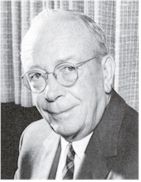Lawrence A. Hyland
- Birthdate
- 1897/08/26
- Birthplace
- Nova Scotia, Canada
- Death date
- 1989/11/24
- Associated organizations
- Naval Research Laboratory, Bendix Corporation
- Fields of study
- Radio, Aircraft
- Awards
- IEEE Founders Medal, Pioneer Award for Aeronautical and Navigation Electronics
Biography
Lawrence A. Hyland was born in Nova Scotia, Canada on 26 August 1897, but came with his family to the United States in 1899. He was raised in Massachusetts where he won Debating League Gold Medals in 1914 and 1915 at the Melrose High School. His only university degree was an Honorary Doctorate of Engineering he received from the Lawrence Institute of Technology in 1954.
Hyland enlisted in the U.S. Army in 1917 and saw extensive combat as a Sergeant of Field Artillery in Europe. He later enlisted in the U. S. Navy and served as a radioman both on cruisers and in aircraft during the pioneering years of naval communications. He was discharged in 1926 as a Chief Radioman.
Hyland joined the Naval Research Laboratory (NRL) as a radio engineer that same year. While at NRL he first demonstrated the reflection of radio waves from aircraft in 1932. His experiments, and those of his colleagues at NRL, were instrumental in the launching of the major developmental program that culminated in radar. Hyland also made basic contributions to doppler radar while at NRL. He invented a device for shielding aircraft ignition systems, which permitted reliable communications with aircraft for the first time.
In 1932, L. A. 'Pat' Hyland founded the Radio Research Company, which was later merged into the Bendix Corporation. At Bendix he rose from Division Manager to Vice President for Research and Engineering, and was deeply involved in all the electronics programs there. During this period he was a member of the Defense Department's Guided Missile and ICBM (Von Neumann) Advisory Committees.
Hyland was granted thirty-nine U. S. Patents during the period 1931 to 1944, either individually or in conjunction with others, in recognition of his original contributions.
Hyland left Bendix in 1954 to take on the role of Vice President and General Manager of the Hughes Aircraft Company, ownership of which had been transferred by Howard Hughes to the Howard Hughes Medical Institute the year before. When he joined Hughes, the company had been plagued by the eccentricity of its founder. Left with a free hand, Hyland's leadership transformed the company into one of the country’s leading defense electronics and communications satellite developers and manufacturers. When Mr. Hughes died in 1976, Hyland became the company’s president and chairman. In 1984, he retired from active service to the firm, around the time of the sale of the company to General Motors.
Hyland served as a senior consultant to the President's Science Advisory Committee (ballistic missiles, air defense, and manned space) , the Atomic Energy Commission (Argonne National Laboratory), and the Central Intelligence Agency. He also served as a member of the Defense Industry Advisory Council.
Hyland also served the California community, where he lived, as a trustee of Harvey Mudd College and the California Museum Foundation, and as a member of the Los Angeles Harbor Commission and the West Valley Water Board. He also served as Director of several companies both in the United States, and abroad.
Hyland's work earned him a number of honors, including the Collier Trophy (along with the Hughes corporation) for the Surveyor moon landing in 1967. In 1950 he received the Distinguished Public Service Award, the highest civilian honor bestowed by the U.S. Navy, for his pioneering contributions to radar, and in 1967, the Armed Forces Communications and Electronics Association gave him the Gold Medal for Meritorious Service to the Country. The Emperor of Japan awarded him Order of the Sacred Treasure for distinguished management.
Hyland joined the IRE in 1929 and became an IEEE Fellow in 1955. The IEEE gave him the Pioneer Award for Aeronautical and Navigation Electronics in 1957 and the 1974 IEEE Founders Medal "For leadership and management in the field of electronics."
Further Research
Hyland, L.A. Call Me Pat: The Autobiography of the Man Howard Hughes Chose to Lead Hughes Aircraft. (Virginia Beach, VA: The Donning Company, 1993)
“L. A. Hyland, Radar Pioneer, 92; Howard Hughes's Top Executive.” New York Times. November 26, 1989.
